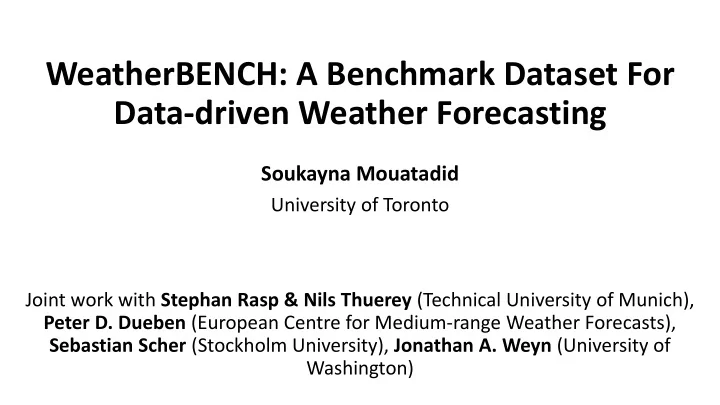

WeatherBENCH: A Benchmark Dataset For Data-driven Weather Forecasting Soukayna Mouatadid University of Toronto Joint work with Stephan Rasp & Nils Thuerey (Technical University of Munich), Peter D. Dueben (European Centre for Medium-range Weather Forecasts), Sebastian Scher (Stockholm University), Jonathan A. Weyn (University of Washington)
Goals • Awareness: Inter-comparability of machine learning weather forecasting studies • Crowdsourced science: WeatherBench dataset • Physics / Machine learning baselines: numerical weather prediction models, neural network models, etc April 26, 2020 Soukayna Mouatadid / University of Toronto
How weather forecasting is done today Traditional weather forecasting involves: • Observation gathering • Data assimilation • Numerical weather prediction • Forecast post-processing and evaluation Concern: • computationally expensive • Poor performance on extreme events Credit: K. Cantner, AGI. April 26, 2020 Soukayna Mouatadid / University of Toronto
Data-driven weather forecasting April 26, 2020 Soukayna Mouatadid / University of Toronto
Data-driven weather forecasting: SOTA? Recent studies: • NNs to predict 500 hPa geopotential 1 hour ahead ( Dueben and Bauer, 2018 ) • CNNs to predict GCM outputs 14 days ahead ( Scher, 2018; Scher & Messori, 2019 ) • CNNs to predict reanalysis derived Z500 at different lead times ( Weyn et al., 2019 ) Concern: • different settings of general circulation models as ground truth • different spatial and temporal resolutions • different neural network architectures evaluated using different metrics April 26, 2020 Soukayna Mouatadid / University of Toronto
WeatherBENCH dataset Goal: Evaluate deep learning models for global medium range weather forecasting Data: ERA5 reanalysis dataset for training and evaluation Spatial resolution: 40 years of hourly data (1979-2018) Temporal resolution: Data re-gridded to 5.625°, 2.8125° and 1.40525° Selected 10 vertical levels between 1 and 1000 hPa April 26, 2020 Soukayna Mouatadid / University of Toronto
WeatherBENCH dataset 3-D fields 2-D fields Time-invariant fields Geopotential 2-meter temperature Land-sea mask Temperature 10-meter wind Soil type Humidity Total cloud cover Orography Wind Precipitation Latitude, longitude Top-of-atmosphere incoming solar radiation April 26, 2020 Soukayna Mouatadid / University of Toronto
WeatherBENCH evaluation Target fields: 500 hPa geopotential and 850 hPa temperature Years: 2017-2018 Resolution: 5.625° Metric: 𝑂 𝑔𝑝𝑠𝑓𝑑𝑏𝑡𝑢𝑡 𝑂 𝑚𝑏𝑢 𝑂 𝑚𝑝𝑜 1 1 𝑧 𝑗,𝑘,𝑙 − 𝑧 𝑗,𝑘,𝑙 ) 2 𝑆𝑁𝑇𝐹 = 𝑀(𝑘) (ො 𝑂 𝑂 𝑚𝑏𝑢 𝑂 𝑚𝑝𝑜 𝑔𝑝𝑠𝑓𝑑𝑏𝑡𝑢𝑡 𝑗 𝑘 𝑙 with 𝑀(𝑘) , the latitude weighting factor for cos(𝑚𝑏𝑢 𝑘 ) the latitude at the 𝑘 𝑢ℎ 𝑀(𝑘) = 1 latitude index 𝑂 𝑚𝑏𝑢 cos(𝑚𝑏𝑢 𝑘 ) 𝑂 𝑚𝑏𝑢 σ 𝑘 April 26, 2020 Soukayna Mouatadid / University of Toronto
Meaningful baselines Persistence: Tomorrow’s weather is today’s weather Climatology: Mean over 1979 – 2016 Operational NWP model: Operational IFS (Integrated Forecast System) from the ECMWF Linear regression Convolutional neural network: Five layer CNN with a filter size of 5 April 26, 2020 Soukayna Mouatadid / University of Toronto
Meaningful baselines April 26, 2020 Soukayna Mouatadid / University of Toronto
Climate forecasts April 26, 2020 Soukayna Mouatadid / University of Toronto
Conclusion We hope the benchmark can provide a starting point for: • Scientific understanding • Challenge for data science • Clear metric for success • Quick start • Reproducibility and citability • Communication platform April 26, 2020 Soukayna Mouatadid / University of Toronto
The end For more details, see: WeatherBENCH: A benchmark dataset for data-driven weather forecasting https://arxiv.org/abs/2002.00469 The benchmark development is ongoing and we encourage you to develop and evaluate your own solutions! https://mediatum.ub.tum.de/1524895 https://github.com/pangeo-data/WeatherBench April 25, 2020 Soukayna Mouatadid / University of Toronto
Sources • Cohen, T. S., Geiger, M., Köhler, J., and Welling, M.: Spherical CNNs, in: 6th International Conference on Learning Representations, ICLR 2018 - Conference Track Proceedings, International Conference on Learning Representations, ICLR, 2018. • Dueben, P. D. and Bauer, P.: Challenges and design choices for global weather and climate models based on machine learning, Geosci. Model Dev., https://doi.org/10.5194/gmd-2018-148, https://www.geosci-model-dev-discuss.net/gmd-2018-148/gmd-2018-148.pdf, 2018. • Scher, S.: Toward Data-Driven Weather and Climate Forecasting: Approximating a Simple General Circulation Model With Deep Learning, Geophysical Research Letters, 45, 616 – 12, https://doi.org/10.1029/2018GL080704, https://onlinelibrary.wiley.com/doi/abs/10.1029/2018GL080704, 2018. • Scher, S. and Messori, G.: Generalization properties of neural networks trained on Lorenzsystems, Nonlinear Processes in Geophysics Discussions, pp. 1 – 19, https://doi.org/10.5194/npg-2019-23, https://www.nonlin-processes-geophys-discuss.net/npg-2019-23/, 2019a. • Scher, S. and Messori, G.: Weather and climate forecasting with neural networks: using general circulation models (GCMs) with different complexity as a study ground, Geoscientific Model Development, 12, 2797 – 2809, https://doi.org/10.5194/gmd-12-2797-2019, https://www.geosci-model- dev.net/12/2797/2019/, 2019b. • Weyn, J. A., Durran, D. R., and Caruana, R.: Can machines learn to predict weather? Using deep learning to predict gridded 500-hPa geopotential height from historical weather data, Journal of Advances in Modeling Earth Systems, p. 2019MS001705, https://doi.org/10.1029/2019MS001705, https://onlinelibrary.wiley.com/doi/abs/10.1029/2019MS001705, 2019. April 26, 2020 Soukayna Mouatadid / University of Toronto
Recommend
More recommend